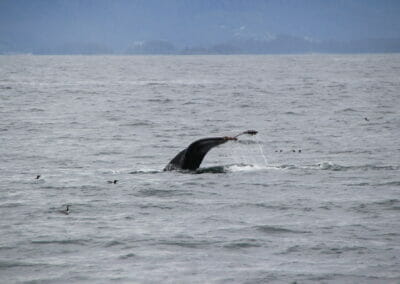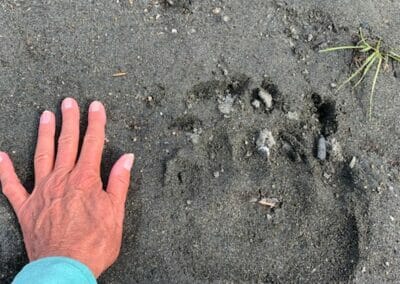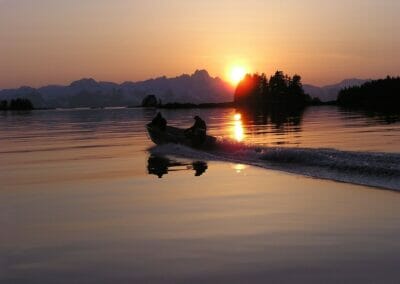Brown Bear
The Alaskan Brown Bear (Ursus Arctos Horribulus) is the ultimate challenge for hunters looking for a True Fair chase while hunting the rainforest of SE Alaska. It is simply unmatched!
Alaska Brown Bear Hunts – What To Expect
All of our hunts are fair chase and based from our vessel the Western Profit. For bear hunts, hunters will be accompanied by one of our guides in skiffs to locate bears, and then put ashore for the stalk. In the Sitka area, on Baranof and Chichagof island’s have some of the highest brown bear populations in the world.
In general bear hunting is more relaxed than many other hunts. Typically the hunt will not begin until afternoon when things have warmed up a bit and bears are more active. So sleeping in is actually a thing on bear hunts! Typically a leisurely breakfast aboard the boat is followed up by a few hours of relaxing glassing where all manner of animals from bears, whales, deer, sea otters, harbor seals, eagles and any number of other species may be observed. Not to mention the amazing scenery that is Southeast Alaska. Or if you’re lucky, go pull up a pot of Dungeness crab for lunch/dinner!
Next comes lunch, which tends to be the heaviest meal of the day. After that hunters and guides launch in the skiffs to begin the hunt. Hunting style, locales, and equipment differ between spring and fall, so we will break those out a bit more below.
Spring Hunts
Spring sees brown bears emerging from their long hibernation in search of their first meal in many months. They look for sedge grass flats along the edge of the water. Sedge grass stalks are spiky, wide, and stiff, but the sedge grass is up to 25% protein at this time of the year. Consuming large quantities of fresh sedge grass helps replenish the lack of proteins during hibernation and restart the digestive system.
During the spring hunters and guides will use skiffs to locate bears and do an initial evaluation on size, quality, and whether a stalk is possible based on current conditions and location. Once a potential bear is located the real excitement begins as the guide works with the hunter to get on land to stalk close enough to get a better view and make a final decision on whether to harvest the bear. This can be extremely tricky as bears have an incredible sense of smell, and the slightest shift in the wind can alert the bear, who will then quickly disappear back into the arboreal rain forest.
Because bears are more wary after emerging from the den in the spring, archery hunting can be a real challenge. While it is not impossible to archery hunt brown bears in the spring, it is much more difficult than the fall when bears tend to congregate around salmon streams, and are focused on putting on as much fat as possible to help them survive hibernation.
While Spring in Alaska is typically warmer than either the Fall or Winter, it can still be chilly out on the water, and rain can definitely be a significant factor during the hunt. You may also run into warm sunny days, with chilly evenings during the return to the boat, so having the right gear will make all the difference in the world. The ability to “layer up, layer down” and keep dry will make a big difference in both your comfort and your success. So make sure to have a look at the recommended gear listing below.


Recommended Gear For Spring Hunts
Clothing For The Hunt
- Merino base layers
- Hip/Chest Waders
- Mid Layers (i.e. Sweatshirt, Fleece)
- Outer Layer For Wind (Kuiu, Sitka Gear, First Lite)
- Rain Gear (Grunden’s)
- Rubber Boots (X-tra Tuffs)
Clothing On The Boat
- Pajamas/Lounging
- Comfortable Shoes/slippers
Miscellaneous
- Personal Toiletries
- Medications
- Favorite Snacks
Fall Hunts
Fall brings streams full of spawning salmon to southeast Alaska. During this time bears are in the last desperate rush to pack on calories before the long winter hibernation. Egg laden salmon in the tight confines of a stream are a bonanza of high fat calorie protein, and the final significant feast before winter sets in and the bears den up until Spring. for this reason bears are hyper focused on feeding, and it is not unusual to see large numbers in a small area simply feeding.
During the Fall the focus shift to these stream bound bears as they gorge themselves on salmon. It is common to see as many as 25 bears on a fall hunt. Hunters and guides will still use skiffs to go from the boat to shore, but then they follow the stream upward to find an appropriate location to observe bears as they come and go. The fall gives a better opportunity for archery hunters du to the close proximity of the bear. How Close? Close enough to see the bear’s breath! Fall hunts are our favorite due to the amount of animal activity!
Fall hunts tend to be colder, and wetter than the Spring hunt, so the right gear, especially rain gear, is even more important.


Recommended Gear For Fall Hunts
Clothing For The Hunt
- Merino base layers
- Chest Waders
- Mid Layers (i.e. Sweatshirt, Fleece)
- Outer Layer For Wind (Kuiu, Sitka Gear, First Lite)
- Rain Gear (Grunden’s)
- Rubber Boots (X-tra Tuffs)
Clothing On The Boat
- Pajamas/Lounging
- Comfortable Shoes
Miscellaneous
- Personal Toiletries
- Medications
- Favorite Snacks



